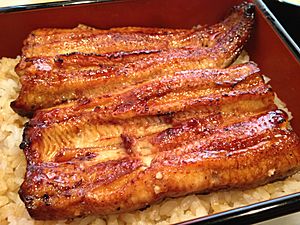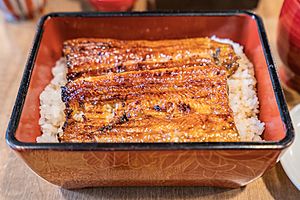Unagi facts for kids

Unaju, Japanese unagi cuisine
|
|
| Main ingredients | Eel |
|---|---|
Unagi (ウナギ) is the Japanese word for freshwater eel. It especially refers to the Japanese eel, which is called Anguilla japonica (日本鰻, nihon unagi). Unagi is a very common food in Japanese cooking. It is often prepared as kabayaki, which means it's grilled with a sweet sauce.
It is important not to confuse unagi with saltwater eel. Saltwater eel is known as anago in Japanese.
Contents
Unagi in Japanese Food
Unagi is often served as part of a dish called unadon. This name sometimes appears as unagidon in restaurants outside Japan. Unadon is a type of donburi dish. It has slices of grilled eel placed on top of a bed of rice.
There is even a sweet cookie called unagi pie. It is made with powdered unagi. Unagi is also very healthy! It has a lot of protein, vitamin A, and calcium.
Where to Find Unagi
You can find special restaurants just for unagi all over Japan. These restaurants often have signs with the Japanese letter hiragana う (pronounced u). This is the first letter of the word unagi.
Lake Hamana in Hamamatsu city, Shizuoka prefecture is famous for having the best quality unagi. Because of this, many small restaurants around the lake specialize in different unagi dishes.
When to Eat Unagi
People in Japan often eat unagi during the hot summer months. There is even a special day for eating unagi. It is called the midsummer day of the Ox (doyo no ushi no hi).
Unakyu is a common term for sushi that contains both eel and cucumber. Eels must always be cooked before eating. This is because raw eel can be poisonous. In Japanese food, unagi is often served with a sweet and savory sauce called tare sauce. If unagi is roasted without tare sauce and only seasoned with salt, it is called "Shirayaki."
Protecting Unagi Eels
The group Seafood Watch helps people choose seafood that is caught or farmed in a way that protects the ocean. They suggest that people avoid eating unagi. This is because there are big problems for freshwater eel populations around the world.
All three types of eel used as unagi have seen their numbers drop a lot in the last 50 years. For example, the number of European eels caught has gone down by about 80% since the 1960s. The Japanese Ministry of the Environment has even added the Japanese eel to its "endangered" list. This means the eel is at risk of disappearing.
Farming Eels
About 90% of the freshwater eel eaten in the U.S. is farm-raised. However, these eels are not truly bred in captivity. Instead, young eels are caught from the wild. Then, they are raised in special pens. This process still reduces the number of eels in the wild.
Also, eels are often farmed in pens that are open to the natural water. This means that parasites, waste, and diseases from the farm can flow directly back into the wild eel areas. This further harms wild eel populations. Freshwater eels are carnivores, meaning they eat other animals. So, farmed eels are fed other fish that are caught from the wild. This adds another problem to how sustainable eel farming is.
See also
 In Spanish: Unagi para niños
In Spanish: Unagi para niños


